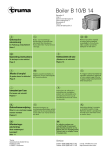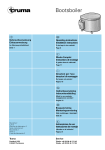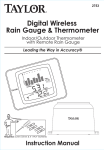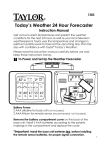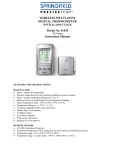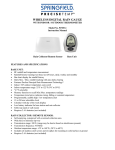Transcript
Transmission Collision Precautions 1. Your Taylor® Wireless Rain Gauge will track the amount of daily, weekly, and monthly rainfall. It will also report total accumulated rainfall, which is the total rainfall recorded since the unit was last reset to zero. Press the “-“ button to toggle between the different displays. Signals from other household devices, such as doorbells, home security systems and entry controls, may temporarily interfere with the rain gauge transmissions. This is normal and does not affect the general performance of this product. The transmission will resume once the interference recedes. This Digital Wireless Rain Gauge is engineered to give you years of satisfactory service if you handle it carefully, following these guidelines: 2. A signal is sent from the transmitter to the receiver every 30 seconds when it is raining. If there is no rainfall, a signal will transmit every 2½ minutes. This signal will update the data on the receiver if any changes have occurred. Trouble-Shooting 2. Do not immerse the receiver unit in water. If you spill liquid on it, dry it immediately with a soft, lint-free cloth. How to Read Rainfall Data 3. As rainfall occurs, the Daily Rainfall Display will show the amount of rain accumulated throughout the day. When the clock reaches midnight, the display for daily rainfall will automatically reset to zero. 4. For the first day of rainfall, the Daily, Weekly, Monthly, and Total rainfall accumulation will be the same. As additional rainfall occurs throughout the week/month, the unit will add the rainfall amounts together for a weekly/monthly/ total rainfall accumulation. 5. The Weekly rainfall total accumulates from Sunday to Saturday. When the clock reaches 12:00am (midnight) every Sunday, the weekly total rainfall will automatically reset to zero. 6. The Monthly rainfall total accumulates from the first day of the calendar month to the last day. When the clock reaches 12:00am (midnight) on the first day of the month, the monthly total rainfall will automatically reset to zero. 7. Total Rainfall accumulates from the first day the rain gauge is put into use. The receiver will continue to record Total Rainfall until the user clears the memory or the batteries are replaced. 8. To manually reset either the Daily, Weekly, Monthly, or Total Rainfall accumulations, first press the “-“ button to select the memory to be cleared. Press the “+” key. The data will reset to zero. Congratulations on your purchase of the Taylor® Digital Wireless Rain Gauge. This state-of-the-art measurement instrument is engineered and designed to meet the highest quality standards…to assure you uncompromising accuracy and consistently dependable, convenient performance. In order to optimize its function, please read this instruction manual carefully before use…and keep it handy for future reference. Description of Parts Receiver Unit 2 3 4 Disconnected Signals If the receiver unit does not receive a transmission for 1 hour, the display will show dashes. To correct this problem: 1. Check that the rain gauge is properly positioned, within a 100' transmission range. 2. Check to make sure the transmission path is clear of obstacles and interference. 3. If new batteries are faulty on the initial installation, install fresh batteries, following the steps in the Battery Installation section of this manual. Note: This equipment has been tested and found to comply with the limits for a Class B digital device, pursuant to Part 15 of the FCC Rules. These limits are designed to provide reasonable protection against harmful interference in a residential installation. This equipment generates, uses, and can radiate radio frequency energy and, if not installed and used in accordance with the instructions, may cause harmful interference to radio communications. However, there is no guarantee that interference will not occur in a particular installation. If this equipment does cause harmful interference to radio or television reception, which can be determined by turning the equipment off and on, the user is encouraged to try to correct the interference by one or more of the following measures: – Reorient or relocate the rain gauge equipment. – Increase the distance between the radio/television equipment and rain gauge receiver. Line 1 6. Do not subject either unit to excessive force, shock, dust, temperature or humidity. This may result in malfunction, shorter electronic life span, damaged batteries or distorted parts. This equipment contains no user-serviceable parts. Do not tamper with either unit's internal components. Doing so will invalidate the warranty on this product and may cause damage. 7. Do not mix old and new batteries. Remove the batteries if this product will not be used for a long time. 8. Always refer to this instruction manual before operating this product. 2. MODE Button Advances clock/calendar settings during Time Setting mode. Resets Daily, Weekly, Monthly, or Total accumulated rainfall data. Cancels the registration between the receiver and transmitter and registers a new signal between the units. 5. Battery Compartment The receiver unit requires 2 AA alkaline batteries (not included). See Battery Installation section of this manual. This product is warranted against defects in materials or workmanship for one (1) year from the date of original purchase. It does not cover damages or wear resulting from accident, misuse, abuse, commercial use, or unauthorized adjustment and/or repair. Should this product require service (or replacement at our option) while under warranty, do not return to retailer. Please pack the item carefully and return it prepaid, along with a store receipt showing date of purchase and a note explaining reason for return to: The transmitter requires 2 AA alkaline batteries (not included). See Battery Installation section of this manual. Rain Gauge Net Rain Gauge Net A protective stainless steel net is placed on top of the rain gauge to guard against rocks, leafs, and other debris collecting in the rain gauge. The net may be removed for cleaning by pulling up on the ring at the side of the net. Important: The rain gauge should not be left outdoors in temperatures at or below -4°F (-20°C) or in snowy weather. If the temperature drops to this level or it begins to snow, remove the rain gauge to an indoor area. Specifications Range of rainfall measurement: Daily: 0-39.33 inches (0-999 millimeters) Weekly: 0-393.66 inches (0-9999 millimeters) Monthly: 0-393.66 inches (0-9999 millimeters) Resolution: 0.04 inches (1 millimeter) Taylor Precision Products 2220 Entrada Del Sol Las Cruces, New Mexico 88001 www.taylorusa.com Accuracy: + / - 3% Transmission: 100 feet (30 meters) in an open area Transmissions sent every 30 seconds during rainfall, otherwise sent every 2½ minutes There are no express warranties except as listed above. This warranty gives you specific legal rights, and you may have other rights which vary from state to state. Clock: Quartz precisions +/- 30 seconds per month DAY The back of the receiver has a recessed key hole to secure the unit to a wall. 6 in WEEK in Battery Life: 1 year (alkaline batteries recommended) Made to our exact specifications in China. Setting Up The Rain Gauge Transmitter Figure: A 1. Hold the MODE button for 3 seconds to enter Time Setting mode. 2. Press “+” or “-“ buttons to select 12 or 24 hour clock mode. Press MODE to enter. 3. Press “+” or “-“ buttons to set the year. Hold down the buttons to advance digits quickly. Press MODE to enter. 4. Continue to set the month, day/date, hour, and minutes by pressing “+” or “-“ and then pressing MODE to enter the data. Hold down the buttons to advance digits quickly. 5. After selecting the minutes and pressing MODE, the clock setup will be complete. 6. If no buttons are pressed within 5 seconds, the clock will revert to its original setting For the initial installation, insert the batteries into the receiver unit first, then the transmitter. Place the receiver and transmitter gauge next to each other during battery installation for best signal initialization. How To Set Up and Use Your Wireless Rain Gauge Use 2 'AA' batteries Receiver: 1. Lift off the battery compartment cover located on the back of the unit. 2. Insert 2 AA alkaline batteries as indicated by the polarity symbols marked inside the battery compartment. 3. After installing the batteries, the display will show flashing dashes. Once the rain gauge's batteries are installed and the unit successfully transmits a signal, the receiver will show zeros. 4. Replace the battery compartment cover. 'A A' 'A A' Important: When the temperature falls below freezing, the batteries of outdoor units may freeze, lowering their voltage supply and effective range. Use Lithium batteries to insure operation below 10°F (-12°C). How to Set and Use Clock & Calendar Functions Unscrew the 2 screws then lift the top casing off Battery Installation Pull the bottom of stand out from the housing for stable placement of the unit on a flat surface. 7. Wall Mount Indoor Thermometer & Clock with Remote Rain Gauge Leading the Way in Accuracy™ Be sure to remove the cardboard insert from under the rain cup before using 'A 'A A' A' 6. Table Stand 5 Digital Wireless Rain Gauge Instruction Manual Battery Compartment Line 1 Daily Rainfall Display. Reports today's total rainfall. Line 2 Weekly/Monthly/Total Accumulated Rainfall Display. Shows either the weekly, monthly, or total accumulated rainfall. The “WEEK” icon appears above the rainfall digits when the receiver is in week mode. The “MONTH” icon appears during monthly mode. If no icon is visible, the total accumulated rainfall is displayed. Press “MODE” to toggle between the different displays. Line 3 Clock and Calendar display. Shows the current time, date, and day of the week. 2750 One Year Warranty ©2004 Taylor Precision Group, LLC and its affiliated companies, all rights reserved. Taylor® is a registered trademark and Leading the Way in Accuracy™ is a trademark of Taylor Precision Products Group, LLC and its affiliated companies. All rights reserved. Remote Rain Gauge Transmitter Reverses clock/calendar settings during Time Setting mode. Toggles between Weekly, Monthly, and Total accumulated rainfall. Switches between inch and millimeter units of measurement. 7 5. Do not clean either unit with abrasive or corrosive materials. This may scratch plastic parts and corrode electronic circuits. 1. LCD Display 4. '" - " Button Line 3 4. Though the transmitter is frost-resistant, it should not be left outdoors in snow or at temperatures at or below -4°F (-20°C). If the temperature falls below this point or if snow accumulates, remove the transmitter to an indoor area. Otherwise, permanent damage to the rain gauge's internal circuits may occur. Main Features & How to Access Functions 3. " + " Button Line 2 3. The transmitter is weather-resistant but not waterproof. Do not immerse the rain gauge in water or allow snow to accumulate in it. If this accidentally occurs, dry it immediately with a soft, lint-free cloth. Modifications not authorized by the manufacturer may void user's authority to operate this device. Enter Time Setting mode. 1 1. The receiver is intended for indoor use only. It is not sealed against moisture and could be damaged if used outdoors. Important: Though the transmitter is weather- and frostresistant, it should never be submerged in water or left outside during snowy weather. Also please note the transmitter should not be left outdoors in temperatures at or below -4°F (-20°C). If the temperature drops to this level, move the transmitter to an indoor area. Both the transmitter and the receiver unit should be kept at temperatures between -4°F (-20°C) to 140°F (60°C). Extreme temperatures outside this range can permanently damage internal circuitry. Unscrew the 4 screws from the battery compartment cover 1. Follow Battery Installation and Clock/Calendar Set Up as directed above. 2. Place the receiver unit as close as possible to the transmitter (they must be within 100 feet of each other). This will ensure easy synchronization between the transmission and reception of signals as you set up your wireless rain gauge. 3. The receiver unit should display zeros after proper battery installation and registration signal initialization. If the receiver still shows dashes, reinstall the receiver's batteries. See Battery Installation section for detailed instructions. Note: The effective transmission range of the rain gauge is 100 feet. The effective range is vastly affected by building materials, physical obstructions (tress, sheds, fountains, etc), and where the receiver and transmitter units are positioned. Try various set ups for the best result. Shorten the distance between the receiver and transmitter units when necessary. Keep the transmitter at least 3 feet from any obstructions which may affect rain collection. For instance, do not place the transmitter gauge under a tree, as water dripping from leaves into the rain cup will overstate actual rainfall. 4. The receiver unit is factory set to display total rainfall in inches. To switch measurement to millimeters, press and hold the "-" button for 3 seconds. The display will switch to millimeters.
